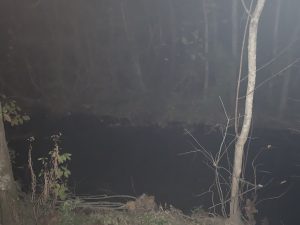
My sit spot in the night-time.
I arrived at my sit spot at 8:16 PM, a time which falls under the general time of day that is classified as night-time. I have never made my observations during the night-time, as I have always opted to do my investigations during the day-time, where the light of day allows me to clearly see my surroundings and make accurate observations. This time, however, I did my observations at night, simply because the assignment required that I make my observations at a different time of day. Although I could have chosen to conduct my investigation at dawn, the truth of the matter is that I would not have been able to bring myself to wake up early enough to witness that time of day.
When I traveled to my sit spot, there was no precipitation and the temperature was relatively high for it being night-time (I approximated that it was around 60 degrees Fahrenheit). The sky was clear and a dark navy blue/ black color; I could see a number of stars in the night sky, but I noted that it was significantly dimmer than the skies I am used to seeing
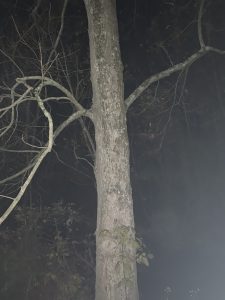
The Black Walnut tree has lost nearly all of its leaves.
in the rural part of Arizona in which I live. My sit spot has changed significantly in the two weeks that I have been absent from it. Primarily, I noticed some changes in each of the things I had been following during the duration of this study. Foremost, the black walnut tree that resides directly south of my sit spot had shedded all of its autumnal foliage, revealing
its white skeletal branches. This was a drastic change from last week when the tree was adorned with vibrant colored leaves of yellow, red, and orange. However, it was not only the black walnut tree that exemplified this change; in fact, nearly every tree in my line of view had also undergone this transformation and lost its leaves, quite possibly marking some of the first signs of winter. Moreover, the flowering Ironweed plant that also sits west of my sit spot had completely died; whereas, two weeks ago the plant was clinging on for life and still retained a few flowers that were alive. Each flower on the plant was now dead, characterized by the shriveled, rust-colored petals, and the leaves of the plant had all turned a pale brown and hung lifelessly from the stem. The death of this plant was curious, however, because the other ironweed plants that grew around my sit spot still showed signs of life, exemplified by their green leaves and vibrant purple flowers; I was unsure why the plant I had chosen to
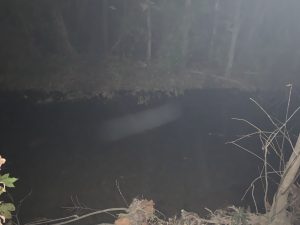
It was extremely hard to see the creek in the darkness.
specifically observe had potentially died prematurely. Furthermore, in the darkness, it was incredibly difficult to make observations pertaining to the creek, as the blanket of darkness made the body of water look like a black vo
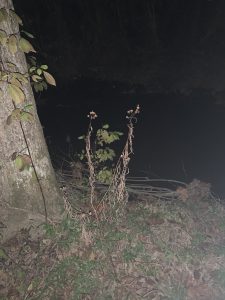
All of the flowers on the Ironweed plant are dead, and the leaves were brown and lifeless.
id. The only way I was able to see a part of the stream was when I stood on the bank and shined my flashlight into the dark waters; it was then that I could see that the stream bed was still covered in the leaf litter that the surrounding trees had contributed. I was also able to see that the water was calm, a stark contrast from my last sit spot when the rain had made the water turbulent; however, although the water appeared to be calm, I routinely heard splashing noises through the night, and I assume these can only be attributed to some unidentified organism.
I initially found that looking for organisms in the darkness proved to be quite the challenge, as it was hard for me to see with such minimal light. However, the light source I did have (provided to me by my phone’s flashlight), proved to be extremely helpful in identifying my first organism, a white moth that I unknowingly lured to me with this light. The moth was quite an interesting insect, as its body almost looked like a cross between a traditional moth and a mosquito. The unknown species of insect was moving its wings with extreme rapidity, and only stopped this behavior when it landed on my phone case. From then on, it seemed to be entranced with the light, as it halted all of its other behaviors from what I could see. My flashlight also proved useful in identifying my second organism, as the light reflected off a spiderweb that clung to the black walnut tree nearby. When I noticed the spiderweb, I began my search for the spider that had spun it and almost immediately identified a minuscule spider that, when I shined the light upon, seemed to sparkle, and its coloring seemed to be black, or perhaps navy blue. The spider remained stationary on the web, but I noticed its legs were moving; thus, I took this as a sign that the creature was continuing to spin its web. At this point in time, I was a bit disappointed with the organisms I had identified, solely because I had expected that doing my sit spot at night would have yielded bigger organisms. Alas, the end of the night did not disappoint, as I witnessed a white-tailed deer on the other side of the bank. The deer most definitely acknowledged my presence as we made intense eye contact for a solid three minutes; however, after it decided I wasn’t a predator, it grazed upon the wild grasses present on the other side of the bank. I decided to move closer to the edge of the creek, in an attempt to better observe the deer, and it did not like that at all. As soon as it saw me move closer, it raised its tail, a phenomenon that I have recently learned is an “alarm- calling” mechanism that alerts other deer that a predator is nearby; after a few more seconds of scoping me out, it darted into the woods. I had never previously been to my sit spot at night, and quite frankly, I have no desire to return to it at this time of day. Foremost, the cover of darkness that the night-time provides makes it extremely difficult to make accurate observations, as it is extremely hard to see one’s surroundings. I had difficulty in finding animals to observe for my blog, but I also had trouble in observing the stream, which is one of the three things that I have decided to follow. I aim for my investigation to be as thorough as possible and conducting it during the night-time seems like it does not enable me to make said thorough observations.
Overall, I would have to say this session was most definitely a negative experience compared to my previous sit spot investigations. Primarily, I was terrified the entire time I was at my sit spot. A bit of background on my terror: I had very recently watched the screen adaptation of Stephen King’s “It” for the first time, and I kept thinking that the clown from the movie was going to kill me in the woods and that no one was going to find my body. Is that a completely absurd line of thinking? Most definitely. However, I still struggled to focus on my observations because I was scared that something was going to pop out of the surrounding shrubbery. Moreover, as I have mentioned previously, the darkness of the night makes it extremely hard to make clear and concise observations. This may have been because I wasn’t equipped with an adequate source of light, but I found that I couldn’t find organisms to observe or that I couldn’t observe some of the abiotic factors (such as the stream) as a whole. As for the organisms I witnessed at my sit spot during this investigation, I didn’t believe them to be anything out of the ordinary. I have seen countless spiders previously, I saw a moth two weeks ago, and I saw a white-tailed deer the first time I did my sit spot; thus, I am not sure that the time of day truly influenced the kinds of organisms I was seeing.

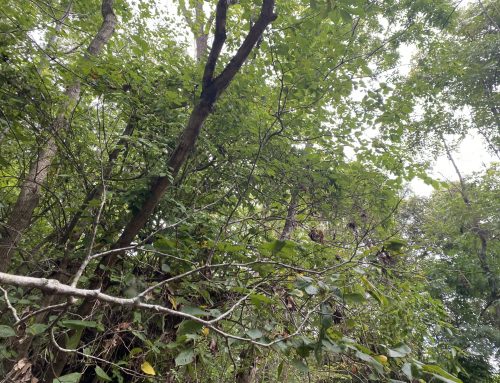
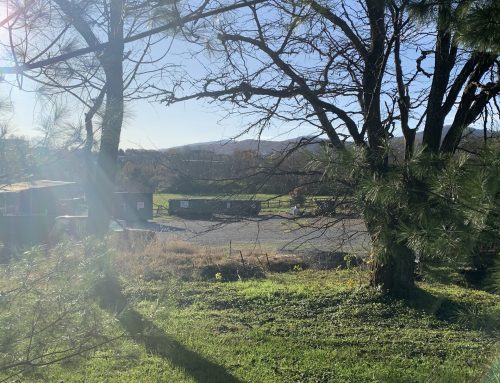
I want to say that I understand the fear that you felt because it is scary to be in the woods by yourself at night. I am also sorry you did not enjoy your time. I really like reading you post and I loved the descriptions that you had in you post. I also like the photo of the Black Walnut tree because it is interesting to see it at night. I also love how you sit spot is next to a creek because that seems calming to me.
Your descriptions of things were great even though you were afraid of being there! I feel like that would be super scary being there in the woods when it is super dark!